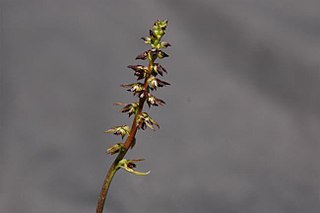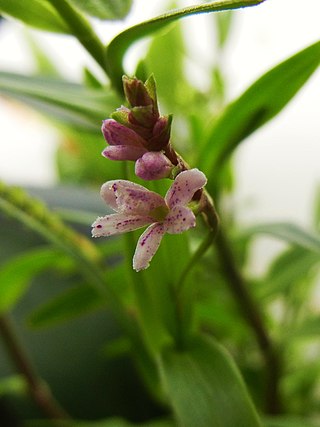
Phragmipedium is a genus of the Orchid family (Orchidaceae) and the only genus comprised in the tribe Phragmipedieae and subtribe Phragmipediinae. The name of the genus is derived from the Greek phragma, which means "division", and pedium, which means "slipper". It is abbreviated 'Phrag' in trade journals.

Aa is a genus of plants of the family Orchidaceae.

Oncidium, abbreviated as Onc. in the horticultural trade, is a genus that, as of December 2023, contains about 340 species of orchids from the subtribe Oncidiinae of the orchid family Orchidaceae. It is distributed across tropical and subtropical America from Mexico, Central America and the West Indies to northern Argentina, with one species (O. ensatum) extending into Florida. Common names for plants in this genus include dancing-lady orchid and golden shower orchid.

Anguloa, commonly known as tulip orchids, is a small orchid genus closely related to Lycaste. Its abbreviation in horticulture is Ang. This genus was described by José Antonio Pavón and Hipólito Ruiz López in 1798. They named it in honor of Francisco de Angulo, Director-General of Mines of Spain.

Phragmipedium kovachii is an orchid species found to be new to science in 2001, native to the Andean cloud forests of northern Peru. A species with terrestrial habit and growing in clumps of several individuals, it displays showy pink to purple flowers up to 20 cm (8 in) wide. It is currently considered a critically endangered species by the IUCN, due to overcollection in the wild.

Masdevallia veitchiana, also known as Veitch's masdevallia or king of the masdevallias, is an orchid species of the genus Masdevallia.

Genoplesium plumosum, commonly known as the Tallong midge-orchid or plumed midge-orchid, is a species of orchid endemic to New South Wales. It is a small orchid only known from a few sites near the towns of Tallong and Wingello on the Southern Tablelands and is only relatively easy to find for about a month, when it flowers. It has been classified as "Endangered" under the EPBC Act.

Epidendrum compressum is a species of flowering plant in the family Orchidaceae . It is from wet montane forests of Trinidad, Venezuela, Colombia, Ecuador, Peru and Bolivia.

Epidendrum macrocarpum, widely known as Epidendrum schomburgkii, is a species of orchid in the genus Epidendrum, and the largest-flowering crucifix orchid species. Reichenbach thought that E. fulgens and E. schomburgkii var. confluens were both synonyms for this species.

Paphiopedilum insigne is an Asian species of slipper orchid and the type species of the genus Paphiopedilum. Its name is derived from the Latin insigne, meaning 'badge of honor' due to the magnificent flower. In the 19th century it was very popular among European and American orchid growers, causing it to become very rare in the wild due to over collecting. There are many varieties of it and hybrids with it.
Epidendrum brachyglossumLindl. 1844 is a species of Epidendrum orchid native to the western slopes of the Andes in Bolivia, Colombia, Ecuador and Peru, and has been reported at altitudes ranging from 1.8 km, near Ocaña, Ayacucho, Peru, to 2.8 km, in Cajamarca, Peru.
Epidendrum smaragdinum is an epiphytic sympodial orchid native to the Neotropics. It has been found at 0.5 km above sea level in Napo, Ecuador It is also known from Brazil, French Guiana, Guyana, Peru, Suriname, and Venezuela.
Epidendrum ruizianum is an epiphytic reed-stemmed Epidendrum of the orchid family native to the cloud forests of Bolivia, Colombia, Ecuador, Peru, and Venezuela, at altitudes of 2–3 km.

Epidendrum calanthum is a terrestrial reed-stemmed Epidendrum orchid from the montane Tropical rainforest of Bolivia, Colombia, Ecuador, Peru, Venezuela, and the West Indies.
Epidendrum adenoglossum is an orchid known primarily from its type herbarium specimen, Mathews 1073, collected in Peru near Pangoa. When Lindley published the name, he placed the species in the subgenus E. subg. SpathiumLindl. (1841). In 2005, Hágsater & Soto designated this species as the lectotype of E. subg. SpathiumLindl. (1841).

Cattleya rex is a species of epiphytic orchid of showy white flowers, native to montane forests in Peru and Bolivia.

Epidendrum fimbriatum is a terrestrial orchid native to high altitudes (2.2—3.4 km) in Bolivia, Colombia, Ecuador, Peru, and Venezuela.
Aa aurantiaca is a species of terrestrial orchid in the genus Aa endemic to the Department of La Libertad in northwestern Peru. It was described by Delsy Trujillo in 2011.

Macodes sanderiana(Kraenzl.) Rolfe is a species of South East Asian jewel orchid mostly recorded from New Guinea but is also found in the Solomon Islands and Vanuatu. This species has a long history of cultivation in Europe since the early 20th century and is prized for its ornamental leaves which are the largest in its genus. The leaves are dark green, the upper surface covered in an intricate network of veins in colors ranging from bright green to copper. In contrast, flowers are small and pallid so are often removed in cultivation. In nature, M. sanderiana grows in rainforests on the forest floor or lithophytically out of rock crevices. This species survives at a broad range of altitudes from close to sea-level, up to the lower boundary of the cloud forest. Exudates from the leaves of this orchid are traditionally used in New Guinea as eye drops for the treatment of myopia. M. sanderiana has not been assessed for the IUCN red list, however, as recently as the 1980’s this species was common in parts of its range within New Guinea.

Dendrobium schuetzei, sometimes called Schuetze's dendrobium, is a species of orchid endemic to northeastern Mindanao, Philippines. Though widely grown as an ornamental, it is classified as Critically Endangered by the IUCN Red List of Threatened Species due to habitat loss and unsustainable harvesting from the wild.
















